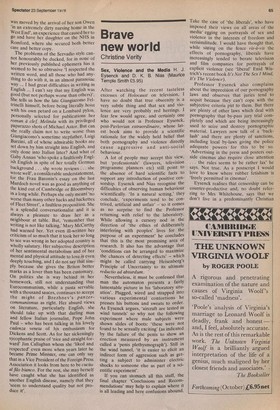Brave new world
Christine Verity
Sex, Violence and the Media H. J. Eysenck and D. K. B. Nias (Maurice Temple Smith £5.95) After watching the recent tasteless excesses of Holocaust on television, I have no doubt that true obscenity is a very subtle thing and that sex and violence are very probably red herrings. I fear few would agree, and certainly one who would not is Professor Eysenck, post-Pavlovian extraordinaire, whose latest book aims to provide a scientific rationale for the widely held belief that both pornography and violence directly cause aggressive and anti-social behaviour.
A lot of people may accept this view, but 'professionals' (lawyers, television programme planners etc) still point to the absence of hard scientific facts to support any introduction of positive censorship. Eysenck and Nias recognise the difficulties of observing human behaviour scientifically. 'In a natural setting,' they conclude, 'experiments tend to be contrived, artificial and unfair' — so it comes as no surprise to find the Professor returning with relief to the laboratory. While allowing a cursory nod in the direction of 'the ethics of deliberately interfering with peoples' lives for the purpose of an experiment' he concludes that this is the most promising area of research. It also has the advantage that 'conditions can be arranged to maximize the chances of detecting effects' — which might be called carrying Heisenberg's Principle of Uncertainty to its ultimate reductio ad absurdum.
Nevertheless, it must be confessed that man the automaton presents a fairly lamentable picture in his 'laboratory situation'. Plugged, wired and strapped into various experimental contortions he presses his buttons and sweats to order. As Eysenck argues, 'aircraft are tested in wind tunnels' so why not the following experiment where male subjects were shown slides of boots: 'these were not found to be sexually exciting' (as indicated by the failure of the penis to show an erection measured by an instrument called a 'penis plethysmograph'). Still in the wind tunnel, 'it is easier to elicit an indirect form of aggression such as getting a subject to administer electric shocks to someone else as part of a scientific experiment'.
If you can stomach all this stuff, the final chapter 'Conclusions and Recommendations' may help to explain where it is all leading and here confusions abound. Take the case of 'the liberals', who have imposed their views on all areas of the media' egging on portrayals of sex and violence in the interests of freedom and verisimilitude. I would have thought that, while sitting on the fence vis-a-vis the effects of pornography, liberals have increasingly tended to berate television and film companies for portrayals of explicit violence (see 'liberal' Enid Wistrich's recent book It's Not The Sex I Mind, It's The Violence).
Professor Eysenck also complains about the imprecision of our pornography laws and observes that juries tend to acquit because they can't cope with the subjective criteria put to them. But there are plenty of other laws which deal with pornography that by-pass jury trial completely and which are being increasingly used to seize and destroy pornographic material. Lawyers now talk of a 'backlash' and there are plenty of sanctions, including local by-laws giving the police adequate powers for this to be so. 'Advertising in the press and posters outside cinemas also require close attention . . the rules seems to be rather lax' he says. Not true. As a postscript I would love to know where rubber fetishism is 'freely permitted in cinemas'.
Eysenck realises that censorship can be counter-productive and, no doubt referring to Mrs Whitehouse, says that we don't live in a predominantly Christian country any longer and should take into account other views. If these were to include the views of the immigrant population, for example Moslems or Sikhs, the censorship laws likely to result would make those of Saudi Arabia pale into insignificance.
The 'Recommendations' themselves involve, generally, more laboratory research. In the case of pornography 'sufferers' should be allowed to view it 'on prescription'. As for the hapless jurors, we should scrap our subjective legal tests and introduce a kind of Benthamite 'Scale of Sexual Activity' for them to work on, ticking off various perversions in the material and then adding up the 'score'. Thankfully, he doesn't introduce such a scale for violence because Shakespeare, Sophocles and Dostoevsky might be sent down for anything up to two years.
Bring back the 'man in the mac' is all I can say at the end of this book. I feel doubly confident in that trivial observation when I read this passage: 'Reactions of children have, for obvious reasons, not been looked at experimentally. This is of particular concern because they would appear to be the most vulnerable', with its almost wistful implied corollary that ways could be found 'scientifically' to test children's reactions to 'hard porn'. Oh brave new world that bath such people in it.



































































































 Previous page
Previous page